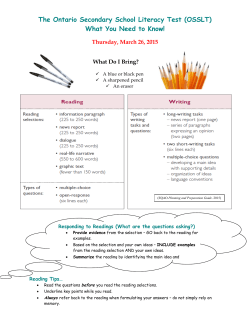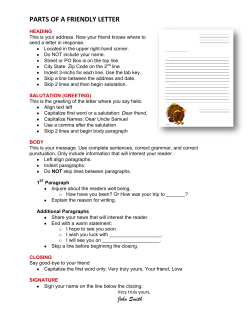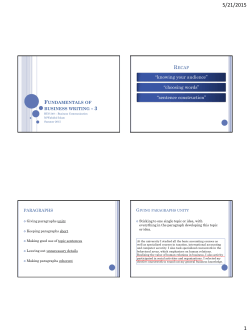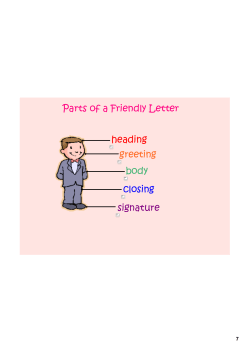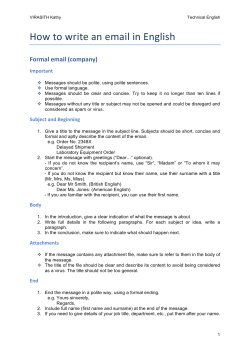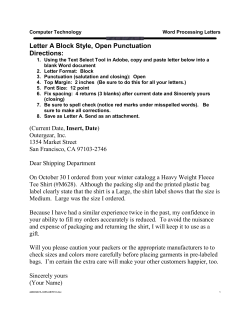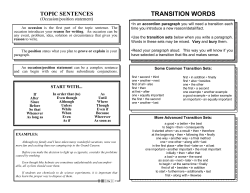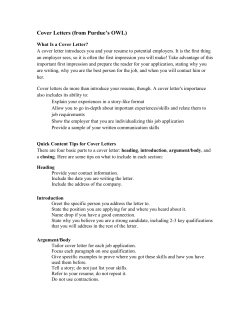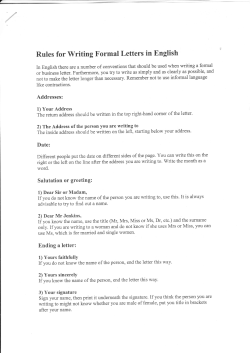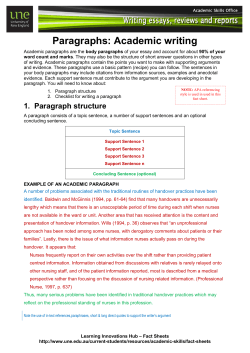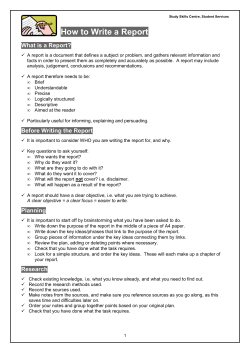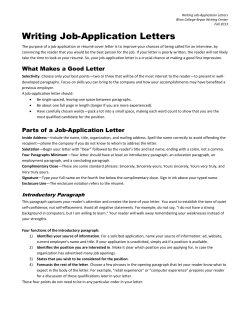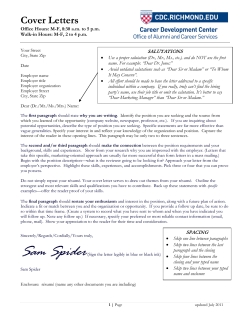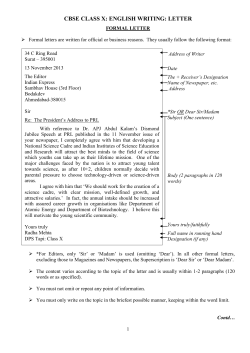
Western Technical College Online Writing Center Business Letters
Western Technical College
Online Writing Center
Business Letters
Business Letters
The business letter is one of the most important communication tools in use today. It is certainly one of
the most effective ways of communicating important information. It holds some significant advantages
over oral forms of communication:
It provides a permanent record of your correspondence.
It can help reduce the chance that the information you communicate will be forgotten before
appropriate action is taken.
It can also be helpful in the event the appropriate action is not taken, and you are forced to
pursue other ways of getting that action. (In other words, a business letter can be a legal
document.)
When to Write a Business Letter
Business letters are certainly not restricted to use within a business setting. There are occasions when
almost everyone must put together a business letter. You may need to write a business letter to:
Apply for a job ("Please hire me.")
Make a consumer complaint ("I'm mad and I'm not going to take it any more.")
Make a private statement on an issue ("Here's how I want you to vote.")
Make public statement on an issue (e.g., letter to the editor) ("Here's what I think.")
Request information ("I would like some information about...")
How to Format a Business Letter
There are many types of business letters, and many ways to write a business letter. It is possible to
apply a generic framework that will work for most business letters. (Keep in mind that while the
framework will work for most business situations, it may not work in all situations.) The generic
framework consists of the following:
Header information
Greeting
Topic paragraph
Supporting paragraph(s)
Conclusion
Closing
Next, we'll look at each of these components.
1
Western Technical College
Online Writing Center
Business Letters
Header information
Header information typically includes:
Your name or your organization's name (optional)*
Your address or your organization’s address*
The current date
Three to eight blank lines**
The name of the person to whom you are writing (recipient)
The title of the recipient (if appropriate)
The address of the recipient
*If you are using letterhead stationery, this information is probably already taken care of, so you won’t
have to worry about it.
**The amount of space you leave between the date line and the recipient information depends on the
length of the letter you are writing. For letters of one page or less, leave as many spaces as you can (up
to a maximum of eight) while keeping the letter to a single page. For letters of more than one page, leave
four lines between the date line and the recipient information.
While there are variances in the placement of header information on a page, it is generally easiest to
keep this information flush with the left margin of your letter.
Greeting
Prepare the greeting as follows:
Leave one blank line between the last line of recipient information and the greeting.
Whenever possible, send your letter to a specific person. You instantly create a more favorable
impression by writing to a person, rather than "To Whom It May Concern." The general format for
a business letter is "Dear" (optional), title, last name, colon:
Dear Ms. Johnson:
Titles may include Mr., Ms., Mrs., Miss, Dr., Prof., etc.
If you are writing to a woman, don't assume marital status. (Use the title Ms. unless you have
evidence that the person prefers Mrs. or Miss.)
There is an important exception to the use of a title and a last name for people you've never met.
If you do not know the gender of the person to whom you are writing, and you are unable to find
out in a reasonable manner, do not use a title. Instead, use both a first and last name.
Dear Robin Jones:
If you have already met or corresponded with the person to whom you are writing, you may have
the option of using a first name followed by a comma.
Dear Robin,
2
Western Technical College
Online Writing Center
Business Letters
This is a judgment call based on the nature of your previous communication with the person. The
use of a first name and a comma implies that you have established a friendly, informal
relationship with a person. Only use the first name and a comma if you have established such a
relationship. (Evidence would include letters or correspondence held on a first name basis.) If in
doubt, use a title, last name, and colon.
Topic (or introductory) paragraph
This is the first paragraph of your letter. You want to accomplish two things in your topic paragraph:
State specifically your purpose for writing (purpose statement). You don't want to leave your
reader trying to figure out why you are writing. In most situations, you'll want to make a clear
statement of purpose.
I am writing to apply for the position of Quality Technician for We Are Widgets, Inc.
I am writing to express my dissatisfaction with the toaster I bought from your company.
An effective business letter states its purpose up front, using the remainder of the body of the
letter to support this purpose statement.
Express, in very general terms, why you are making your purpose statement (qualifying
statement).
My extensive education and experience in Quality Technology will enable me to make a positive
contribution to We Are Widgets.
The toaster has been in for repairs on three occasions in the seven months that I have owned it
and is again in need of repair.
Your qualifying statement will be the focus of the major chunk of the letter's body—the supporting
paragraphs.
Supporting paragraph(s)
To lend credibility to your qualifying statement, you'll write one or more supporting paragraphs. Each
supporting paragraph should focus on supporting a specific aspect of your qualifying statement. For
example, consider the following qualifying statement:
My extensive education and experience in Quality Technology will enable me to make a positive
contribution to We Are Widgets.
You will need to write at least two supporting paragraphs—one discussing your educational background,
and one discussing your experience. In the case of a letter of application, your supporting paragraphs will
not provide the detail of a resume, but will provide enough information to entice your reader to look at
your resume. For other types of letters, you will need to provide as much detail as is necessary to meet
your purpose.
3
Western Technical College
Online Writing Center
Business Letters
Conclusion
No matter how well you have structured your letter to this point, you don't want to assume that your
reader will make the connection between your qualifying statement and your supporting paragraphs.
Therefore, you'll want to write a conclusion. A concluding paragraph restates your qualifying statement,
tying it to your supporting paragraphs.
My college coursework in total quality management, and my seven years experience as a quality
technician provides a strong knowledge base that I can bring to We Are Widgets.
Closing
Finally, you'll need to write a closing to your letter. The closing contains the following:
A statement of what you want from the reader. Regardless of how convincing you are with your
introductory, supporting, and concluding paragraphs, your reader may not know how to respond if you
don't state what you want.
I would welcome the opportunity to meet with you to discuss the position.
A gracious closing statement. It's always good to follow a request with a gracious closing statement.
This makes your final impression a favorable one.
Thank you for your consideration.
“Sincerely,” (or some other appropriate word or phrase)
Your signature (Allow three blank lines for this.)
Your name, typed below your signature
Examples of Business Letters
[[LINK TO WINK BUSINESS LETTERS]]
© 2003-2010 by Daniel Rooney
Updated 2-16--10
4
© Copyright 2025



